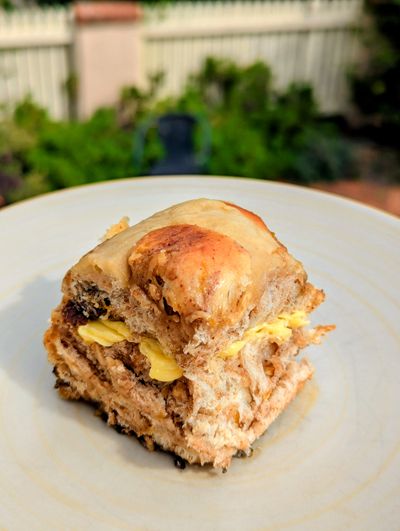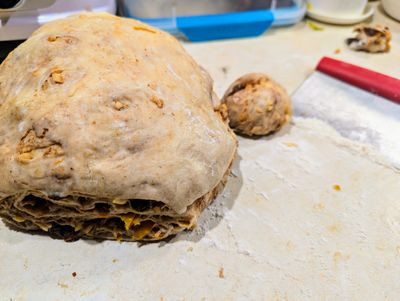Hot cross buns - Recipe

Full ingredients / shopping list
- 75g sultanas
- 50g dried peel
- zest of 1 orange
- 1 green apple, peeled and chopped
- 300g milk
- 50g butter
- 1 egg (large, 50g), or 50g egg mix
- spices (some of: cinnamon, allspice, nutmeg, cloves, ginger)
- 500g bread flour
- 75g flour (any type)
- 5g (1 tsp) salt
- 75g caster sugar
- 7g (2 tsp) instant yeast
Process
1. Soak fruit - Night before
In a small bowl mix together:
- 75g sultanas
- 50g dried peel
- zest of 1 orange
- enough water to cover
Leave several hours or overnight
Drain the liquid, keep both the fruit and liquid parts
2. Milk mixture
In a small pot place:
- 300g milk
Bring to a light boil, then remove from heat
Add to the milk pot:
- 50g butter
Cool to 40°C before use, should feel warm to touch
3. Spice mixture
I’ve done a few different spice mixtures, they all come across very different, but all lovely. There’s a lot of flexibility to vary the spice mix and tune the flavour to your own preferences.
Option 1 - boring spicing:
- 1 tsp of cinnamon
Option 2 - heavily spiced:
- 1/2 tsp of cinnamon
- 1/2 tsp of allspice
- 1/2 tsp of nutmeg
- 1/2 tsp of cloves
- 1/2 tsp of ginger
Option 3 - no spice:
I once forgot the spice and it actually turned out really well. Without the spice the fruit really shines through and has a great clean flavour.
4. Mix
In a stand mixer bowl place:
- 500g bread flour
- 5g (1 tsp) salt
- 75g caster sugar
- 7g (2 tsp) instant yeast
- 1 egg, beaten
- milk mixture
Note place the salt and sugar on one side of the bowl and the yeast on the other side. Yeast is alive and resting on pure salt or sugar will kill it.
Kneed for approximately eight minutes, until a window forms
Transfer to an oiled bowl
5. Proof and add flavour
Place dough somewhere warm to rise for one hour, should double in size
To dough bowl add:
- Soaked fruit
- Spice mixture
- 1 medium sized green apple, peeled and diced
Fold until incorporated.
6. Proof and form

Rise for one hour
Form 75g buns
Place each bun in a high sided tray, sitting close
Proof for one hour
Preheat oven, 200°C fan forced
If you have a baking tile put it in, it helps the bottom cook better.
7. Cross decoration
In a small bowl mix:
- 75g flour
- 5 tbsp water
This should form a thick paste
Pipe the paste onto the buns to form crosses
8. Bake
Place in oven, bake for 20 minutes
9. Glaze
In a small pot place:
- Soaked fruit liquid
Reduce on stove to a thick glazing consistency
Glaze while buns are hot
Logic
Soaking
Dried fruit will pull moisture in to rehydrate itself. If you don’t soak it in advance it pulls that moisture from the dough upsetting the texture.
I feel the dried peel is very important. The great travesty of commercial hot cross buns is that most of them have moved away from peel, frankly it is the main reason I bake my own. The orange zest further ups the peel flavour without adding volume.
A longer soak pulls some of the sugar out and prepares for a fantastic glaze.
Milk stage
Scalding the milk is a standard bread technique. It denatures the whey proteins in the milk, this makes the milk more accessible to the yeast. Not doing this step prevents or slows the yeast growth.
The subsequent cooling is to prevent the heat killing the yeast when they are mixed together.
Adding the butter here is just convenient.
Mix
The mix recipe dough is basically a standard sweet bread recipe, I think I might have amalgamated two I found. The window forming is a standard bread making test, you pull the dough, if it thins to a slightly transparent window then it is done, if it tears first it needs more kneading.
Proof and add flavour
My goal with this recipe was to shove as much fruit in there as I could. I believe fruit is a bit expensive, more expensive than flour at least, which is why commercial bakeries all are light on the fruit.
However just slamming dried fruit in there turns out to be overwhelming and far too sweet, which is why I use the apple. The diced apple essentially disappears, nobody notices that apple is there. It doesn’t directly contribute flavour or colour, I feel it mellows out the overall flavour profile. Texturally though it is lovely, it feels like fruit, so you identify it as such while eating it, it also adds some freshness.
Doing this after the first rise means the dough has more strength to better carry more fruit. It also makes the spice a little inconsistent, you get interesting streaks rather than a constant even flavour.
Proof and form
Shaping the bread properly is important, it gives structure to the bread, creates the good strong crust and allows more advanced crust shaping techniques. It also seems to be the step most neglected by home bakers.
There is a standard technique to rolling a bread bun or roll, the same technique works for hot cross buns. I encourage looking at a few guides and it takes some practice to get right, the amount of fruit makes also it harder. The chef who taught me could do two at a time, one in each hand, the bastard.
Glaze
Using the soak liquid for the glaze solidifies the orange flavour into the buns.
The peel and zest means that the soak liquid is packed full of orange flavour, and sugar. Using it for the glaze reinforces that flavour back into the bun.